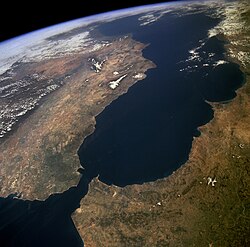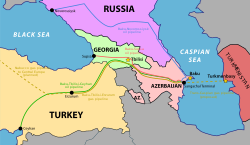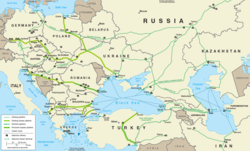List of critical foreign dependencies
The 2008 CFDI list, as redacted by WikiLeaks, listed the following infrastructures: [22] [23]
Sea ports
A number of sea ports were listed, including several Chinese ports (Shanghai Port, Guangzhou Port, Hong Kong Port, Ningbo Port, [4] Tianjin Port [24] ) as well as one Taiwanese port (Kaohsiung Port [24] [25] ) and several European ports (Port of Antwerp, [26] Port of Hamburg, [27] Rotterdam Port [28] ).
Cable routes
Northern hemisphere
- Bermuda - GlobeNet, formerly Bermuda US-1 (BUS-1) undersea cable landing Devonshire, Bermuda [29]
- Canada - Hibernia Atlantic undersea cable landing at Herring Cove, Nova Scotia, Canada [30]
- China - C2C Cable Network undersea cable landings at Chom Hom Kok, Tseung Kwan O, and Shanghai; China-US undersea cable landings at Chongming and Shantou; and FLAG/REACH North Asia Loop undersea cable landing as Tong Fuk [31]
- Denmark - TAT-14 undersea cable landing, Blaabjerg, Denmark [32]
- Fiji - Southern Cross undersea cable landing, Suva, Fiji [33]
- France - APOLLO undersea cable, Lannion, France; [34] FA-1 undersea cable, Plerin, France; [35] and TAT-14 undersea cable landing St. Valery, France [35]
- French Guiana - Americas-II undersea cable landing Cayenne, French Guiana [36]
- Germany - TAT-14 undersea cable landing, Norden, Germany; [27] Atlantic Crossing-1 (AC-1) undersea cable landing Sylt [34]
- Ireland - Hibernia Atlantic undersea cable landing, Dublin Ireland [37]
- Japan - C2C Cable Network undersea cable landings in Chikura, Ajigaura, and Shima; China-US undersea cable in Okinawa; FLAG/REACH North Asia Loop undersea cable landing in Wada; Japan-US undersea cable landings at Maruyama and Kitaibaraki; KJCN undersea cable landings at Fukuoka and Kita-Kyushu; Pacific Crossing-1 (PC-1) undersea cable landing in Ajigaura and Shima; and Tyco Transpacific undersea cable landings in Toyohashi and Emi.
- Martinique - Americas-II undersea cable landing Le Lamentin, Martinique [36]
- Mexico - FLAG/REACH North Asia Loop undersea cable landing, Tijuana [38] and Pan-American Crossing (PAC) undersea cable landing, Mazatlan [38]
- Netherlands - Atlantic Crossing-1 (AC-1) undersea cable landing, Beverwijk; [28] TAT-14 undersea cable landing, Katwijk [28]
- Panama - FLAG/REACH North Asia Loop undersea cable landing Fort Amador, Panama [36]
- Philippines - C2C Cable Network undersea cable landing, Batangas, Philippines; [39] and EAC undersea cable landing Cavite, Philippines [39]
- Republic of Korea - C2C Cable Network undersea cable landing, Pusan, Republic of Korea; [39] EAC undersea cable landing Shindu-Ri, Republic of Korea; [39] FLAG/REACH North Asia Loop undersea cable landing Pusan, Republic of Korea; [24] and KJCN undersea cable landing Pusan, Republic of Korea
- Singapore - C2C Cable Network undersea cable landing, Changi, Singapore; [39] EAC undersea cable landing Changi North, Singapore; [39] C2C Cable Network undersea cable landing, Changi, Singapore; [39] and EAC undersea cable landing Changi North, Singapore [39]
- Taiwan- C2C Cable Network undersea cable landing, Fangshan, Taiwan; [24] [25] C2C Cable Network undersea cable landing, Tanshui, Taiwan; [24] [25] China-US undersea cable landing Fangshan, Taiwan; [24] [25] EAC undersea cable landing Pa Li, Taiwan; [24] [25] FLAG/REACH North Asia Loop undersea cable landing Toucheng, Taiwan [24] [25] [31]
- Trinidad and Tobago - Americas-II undersea cable landing Port of Spain [40]
- United Kingdom - APOLLO undersea cable landing Bude, Cornwall Station, United Kingdom; [41] Atlantic Crossing-1 (AC-1) undersea cable landing Whitesands Bay; FA-1 undersea cable landing Skewjack, Cornwall Station; [42] Hibernia Atlantic undersea cable landing, Southport, United Kingdom; [42] TAT-14 undersea cable landing Bude, Cornwall Station, United Kingdom; [43] Tyco Transatlantic undersea cable landing, Highbridge, United Kingdom; [44] Tyco Transatlantic undersea cable landing, Pottington, United Kingdom; [44] and Yellow/Atlantic Crossing-2 (AC-2) undersea cable landing Bude, United Kingdom [43]
- Venezuela - Four cable landing sites in Venezuela. [45] GlobeNet undersea cable landings at Punta Gorda, Catia La Mar, and Manonga [45]
Southern hemisphere
- Australia - Southern Cross undersea cable landings at Brookvale [19] and Sydney, Australia [46]
- Brazil - Americas-II undersea cable landing at Fortaleza; [36] GlobeNet undersea cable landing at Fortaleza; [36] and GlobeNet undersea cable landing Rio de Janeiro [36]
- Netherlands Antilles - Americas-II undersea cable landing, Willemstad [36]
- New Zealand - Southern Cross undersea cable landing, Whenuapai, New Zealand; [47] and Southern Cross undersea cable landing, Takapuna, New Zealand [47]
Mineral resources

- Australia - Manganese - Battery grade, natural; battery grade, synthetic; chemical grade; ferro; metallurgical grade; [48] Nickel Mines [49]
- China - Fluorite (Mine); Germanium Mine; [24] Graphite Mine; [13] Rare-earth minerals/elements; [24] Tin Mine and Plant; and Tungsten - Mine and Plant [13]
- Democratic Republic of Congo - Cobalt (Mine and Plant) [50]
- Gabon - Manganese - Battery grade, natural; battery grade, synthetic; chemical grade; ferro; metallurgical grade [48] [51] [52]
- Guinea - Bauxite (Mine) [48]
- South Africa - Chromite mines around Rustenburg; [20] Ferrochromium; [53] Manganese - Battery grade, natural; battery grade, synthetic; chemical grade; ferro; metallurgical grade; [51] Palladium Mine and Plant; Platinum Mines; and Rhodium
- Indonesia - Tin Mine and Plant [54] [55]
- Japan - Iodine Mine
- Belgium - Germanium Mine
- Norway - Cobalt Nickel Mine [48]
- Russia - Uranium Nickel Mine: Used in certain types of stainless steel and superalloys; [56] Palladium Mine and Plant; [56] and Rhodium [56]
- Ukraine - Manganese - Battery grade, natural; battery grade, synthetic; chemical grade; ferro; metallurgical grade [56]
- Kazakhstan - Ferrochromium Khromtau Complex, Kempersai, (Chromite Mine) [56]
- India -Orissa (chromite mines) and Karnataka (chromite mines) [48]
- Brazil - Iron Ore from Rio Tinto Mine; [36] Manganese - Battery grade, natural; battery grade, synthetic; chemical grade; ferro; metallurgical grade; [36] Niobium (Columbium), Araxa, Minas Gerais State (mine); [36] and Ouvidor and Catalao I, Goias State: Niobium [36]
- Chile - Iodine Mine [38]
- Canada - Germanium Mine; Graphite Mine; Iron Ore Mine; Nickel Mine; Niobec Mine, Quebec, Canada: Niobium [30]
- Mexico - Graphite Mine [36]
- Peru - Tin Mine and Plant [57] [58]
Other sites
Africa
Morocco

- Strait of Gibraltar [13]
- Maghreb-Europe (GME) gas pipeline, Morocco [20]
South Africa
- BAE Land System OMC, Benoni, South Africa [20]
- Brown David Gear Industries LTD, Benoni, South Africa [59]
Tunisia
East Asia and the Pacific
Australia
- Maybe Faulding Mulgrave (F H Faulding) [61] Victoria, Australia: Manufacturing facility for Midazolam injection. [19]
- Mayne Pharma (fill/finish), Melbourne, Australia: Sole suppliers of Crotalid Polyvalent Antivenin (CroFab) [46]
China
- Hydroelectric Dam Turbines and Generators
- Polypropylene Filter Material for N-95 Masks [24]
Indonesia
- Straits of Malacca [54]
Japan
Republic of Korea
- Hitachi Large Electric Power Transformers 230 - 500 kV Busan Port [21]
Malaysia
Singapore
- Straits of Malacca [13]
Europe and Eurasia
Austria
- Baxter AG, Vienna, Austria: Immune Globulin Intravenous (IGIV) [62]
- Octapharma Pharmazeutika, Vienna, Austria: Immune Globulin Intravenous (IGIV) [63]
Azerbaijan

Belarus

Belgium
Denmark
- Bavarian Nordic (BN), Hejreskovvej, Kvistgard, Denmark: Smallpox Vaccine [21]
- Novo Nordisk Pharmaceuticals, Inc. Bagsvaerd, Denmark: Numerous formulations of insulin [50]
- Novo Nordisk Insulin Manufacturer: Global insulin supplies [41]
- Statens Serum Institut, Copenhagen, Denmark: DTaP (including D and T components) pediatric version [32]
France
- Sanofi-Aventis Insulin Manufacturer: Global insulin supplies Foot-and-mouth disease Vaccine finishing [66]
- Alstom, Hydroelectric Dam Turbines and Generators [41]
- Alstrom Electrical Power Generators and Components [41]
- EMD Pharms Semoy, France: Cyanokit Injection [67]
- GlaxoSmithKline, Inc. Évreux, France: Influenza Neuraminidase inhibitor RELENZA (Zanamivir) [68]
- Diagast, Cedex, France: Olympus (assists with detecting blood group) [35]
- Genzyme Polyclonals SAS (bulk), Lyon, France: Thymoglobulin [68]
- Sanofi Pasteur SA, Lyon, France: Rabies virus vaccine [69]
Georgia
- Baku-Tbilisi-Ceyhan Pipeline [56]
Germany
- BASF Ludwigshafen: World's largest integrated chemical complex [41]
- Siemens Erlangen: Essentially irreplaceable production of key chemicals [25]
- Siemens, GE, Hydroelectric Dam Turbines and Generators [27]
- Draeger Safety AG & Co., Lübeck, Germany: Critical to gas detection capability [27]
- Junghans Microtec Dunningen-Seedorf, Germany: Critical to the production of mortars [70] [ unreliable source? ]
- TDW-Gesellschaft Wirksysteme, Schroebenhausen, Germany: Critical to the production of the Patriot Advanced Capability Lethality Enhancement Assembly [71]
- Siemens, Large Electric Power Transformers 230 - 500 kV [27]
- Siemens, GE Electrical Power Generators and Components [27]
- Druzhba Oil Pipeline [65]
- Sanofi Aventis Frankfurt am Main, Germany: Lantus Injection (insulin) [63]
- Heyl Chemish-pharmazeutische Fabrik GmbH: Radiogardase (Prussian blue) [72]
- Hameln Pharmaceuticals, Hameln, Germany: Pentetate Calcium Trisodium (Ca DTPA) and Pentetate Zinc Trisodium (Zn DTPA) for contamination with plutonium, americium, and curium [25]
- IDT Biologika GmbH, Dessau Rossiau, Germany: BN Small Pox Vaccine [25]
- Biotest AG, Dreiech, Germany: Supplier for TANGO (impacts automated blood typing ability) [72]
- CSL Behring GmbH, Marburg, Germany: Antihemophilic factor/von Willebrand factor [72]
- Novartis Vaccines and Diagnostics GmbH, Marburg, Germany: Rabies virus vaccine [25]
- Vetter Pharma Fertigung GmbH & Co KG, Ravensburg, Germany (filling): Rho(D) IGIV [72]
Ireland
- Genzyme Ireland Ltd. (filling), Waterford, Ireland: Thymoglobulin [37]
Italy
Poland
- Druzhba Oil Pipeline [65]
Russia
- Novorossiysk Export Terminal [56]
- Primorsk Export Terminal [56]
- Nadym Gas Pipeline Junction: The most critical gas facility in the world [48] [56]
Spain

- Strait of Gibraltar [41]
- Instituto Grifols, SA, Barcelona, Spain: Immune Globulin Intravenous (IGIV) [41]
- Maghreb-Europe (GME) gas pipeline, Algeria [34] [41]
Sweden
- Recip AB Sweden: Thyrosafe (potassium iodine) [71]
Switzerland
- Hoffman-LaRoche, Inc. Basel, Switzerland: Tamiflu (oseltamivir) [63]
- Berna Biotech, Berne, Switzerland: Typhoid vaccine [74]
- CSL Behring AG, Berne, Switzerland: Immune Globulin Intravenous (IGIV) [63]
Turkey
United Kingdom
- Goonhilly Teleport, Goonhilly Downs, United Kingdom [43]
- Madley Teleport, Stone Street, Madley, United Kingdom [21]
- Martelsham Teleport, Ipswich, United Kingdom [21]
- Foot and Mouth Disease Vaccine finishing [42]
- BAE Systems (Operations) Ltd., Presont [Preston], Lancashire, United Kingdom: Critical to the F-35 Joint Strike Fighter [76]
- BAE Systems Operations Ltd., Southway, Plymouth Devon, United Kingdom: Critical to Extended Range Guided Munitions [34]
- BAE Systems RO Defence, Chorley, United Kingdom: Critical to the Joint Standoff Weapon (JSOW) AGM-154C (Unitary Variant) [18]
- MacTaggart Scott, Loanhead, Edinburgh, Lothian, Scotland, United Kingdom: Critical to the Ship Submersible Nuclear (SSN) [56]
Near/Middle East
Djibouti
- Bab al-Mendeb: Shipping lane is a critical supply chain node [20]
Egypt
- 'Ayn Sukhnah-SuMEd Receiving Import Terminal [20]
- 'Sidi Kurayr-SuMed Offloading Export Terminal Suez Canal [20]
Iran

Iraq
Israel
- Rafael Ordnance Systems Division, Haifa, Israel: Critical to Sensor Fused Weapons (SFW), Wind Corrected Munitions Dispensers (WCMD), Tail Kits, and batteries [48]
Kuwait
- Mina' al Ahmadi Export Terminal [60]
Oman
Qatar
- Ras Laffan Industrial Center: By 2012 Qatar will be the largest source of imported LNG to U.S. [60]
Saudi Arabia
- Abqaiq Processing Center: Largest crude oil processing and stabilization plant in the world [48]
- Al Ju'aymah Export Terminal: Part of the Ras Tanura complex [60]
- As Saffaniyah Processing Center [60]
- Qatif Pipeline Junction [60]
- Ras at Tanaqib Processing Center [60]
- Ras Tanura Export Terminal [60]
- Shaybah Central Gas-oil Separation Plant [60]
United Arab Emirates (UAE)
- Das Island Export Terminal
- Jabal Zannah Export Terminal [60]
- Strait of Hormuz [13]
Yemen
- Bab al-Mendeb: Shipping lane is a critical supply chain node [60]
South and Central Asia
India
- Generamedix Gujurat, India: Chemotherapy agents, including fluorouracil and methotrexate [77] [78]
Western Hemisphere
Argentina
Canada
- James Bay Power Project, Quebec: monumental hydroelectric power development [30]
- Mica Dam, British Columbia: Failure would impact the Columbia River Basin [30]
- Hydro Quebec, Quebec: Critical irreplaceable source of power to portions of Northeast U. S. [79]
- Robert Moses-Robert H. Saunders Power Dam: Part of the St. Lawrence Power Project, between Barnhart Island, New York, and Cornwall, Ontario [30]
- Seven Mile Dam, British Columbia: Concrete gravity dam between two other hydroelectric power dams along the Pend d'Oreille River [30]
- Pickering Nuclear Power Plant, Ontario [30]
- Chalk River Nuclear Facility, Ontario: Largest supplier of medical radioisotopes in the world [41]
- Hydrofluoric Acid Production Facility, Allied Signal, Amherstburg, Ontario [30]
- Enbridge Pipeline Alliance Pipeline: Natural gas transmission from Canada Maritime and Northeast Pipeline: Natural gas transmission from Canada [30]
- TransCanada Gas: Natural gas transmission from Canada [30]
- Alexandria Bay Point of Entry (POE), Ontario: Northern border crossing [30]
- Ambassador Bridge Point of Entry, Ontario: Northern border crossing [30]
- Blaine POE, British Columbia: Northern border crossing [30]

Pacific Highway Border Crossing - Blaine WA/Douglas BC - Blaine Washington Rail Crossing, British Columbia [30]
- Blue Water Bridge POE, Sarnia, Ontario: Northern border crossing [30]
- Champlain Bridge POE, Quebec: Northern border crossing [30]
- CPR Tunnel Rail Crossing, Ontario (Michigan Central Rail Crossing) [30]
- International Bridge Rail Crossing, Ontario International Railway Bridge Rail Crossing [30]
- Lewiston-Queenston POE, Ontario: Northern border crossing [30]
- Peace Bridge POE, Ontario: Northern border crossing [30]
- Pembina, North Dakota POE, North Dakota/Manitoba border crossing. [80] [81]
- North Portal Rail Crossing, Saskatchewan [82]
- St. Clair Tunnel Rail Crossing between Sarnia,Ontario and Port Huron, Michigan [30]
- Waneta Dam, British Columbia: Earthfill/concrete hydropower dam [30]
- Darlington Nuclear Power Plant, Ontario, Canada [30]
- E-ONE Moli Energy, Maple Ridge, British Columbia, Canada: Critical to production of various military application electronics [83]
- General Dynamics Land Systems - Canada, London Ontario, Canada: Critical to the production of the Stryker/USMC LAV Vehicle Integration [30]
- Raytheon Systems Canada Ltd. ELCAN Optical Technologies Division, Midland, Ontario: Critical to the production of the AGM-130 Missile [34]
- Thales Optronique Canada, Inc., Montreal, Quebec: Critical optical systems for ground combat vehicles [30]
- Cangene, Winnipeg, Manitoba: Plasma [84]
- Sanofi Pasteur Ltd., Toronto, Canada: makers of polio virus vaccine [30]
- GlaxoSmithKline Biologicals, North America, Quebec: Pre-pandemic influenza vaccines [85]
Mexico
- Amistad International Dam: On the Rio Grande near Del Rio, Texas and Ciudad Acuna, Coahuila, Mexico [86]
- Anzalduas Dam: Diversion dam south of Mission, Texas, operated jointly by the U.S. and Mexico for flood control [38]
- Falcon International Dam: Upstream of Roma, Texas and Miguel Aleman, Tamaulipas, Mexico [86]
- Retamal Dam: Diversion dam south of Weslaco, Texas, operated jointly by the U.S. and Mexico for flood control [38]
- GE Hydroelectric Dam Turbines and Generators: Main source for a large portion of larger components [36]
- Bridge of the Americas (El Paso – Ciudad Juárez): Southern border crossing [38]
- Brownsville POE: Southern border crossing [38]
- Calexico East POE: Southern border crossing [38]
- Colombia-Solidarity Bridge: Southern border crossing [38]
- Kansas City Southern de Mexico (KCSM) Rail Line, (Mexico) [87]
- Nogales POE: Southern border crossing [88]
- Laredo Rail Crossing [38]
- Eagle Pass Rail Crossing [38]
- Southern border crossings, Otay Mesa Crossing, World Trade Bridge, and Ysleta Zaragosa Bridge [38]
- Pharr International Bridge: Southern border crossing [36]
- Hydrofluoric Acid Production Facility [38]
- GE Electrical Power Generators and Components [36]
- General Electric, Large Electric Power Transformers 230 - 500 kV [36]
Panama
Trinidad and Tobago
- Atlantic LNG: Provides 70% of U.S. natural gas import needs [40]
